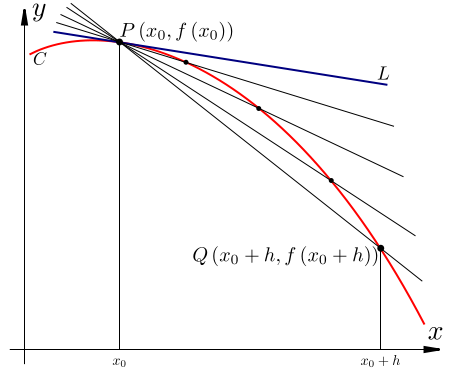Derivatives Rates of Change
Contents
Average Rate of Change
Rate of Change is used to describe the ratio of a change in one variable compare to a change of another variable
If there is a function then the rate of change of the function correspond to the rate of change of variable z is
For example, if there are two points and , then
The Rate of Change of a Function at a Point
Consider the formula for average velocity in the direction, , where is the change in over the time interval . This formula gives the average velocity over a period of time, but suppose we want to define the instantaneous velocity. To this end we look at the change in position as the change in time approaches 0. Mathematically this is written as: , which we abbreviate by the symbol . (The idea of this notation is that the letter denotes change.) Compare the symbol with . The idea is that both indicate a difference between two numbers, but denotes a finite difference while denotes an infinitesimal difference. Please note that the symbols and have no rigorous meaning on their own, since , and we can't divide by 0.
(Note that the letter is often used to denote distance, which would yield . The letter is often avoided in denoting distance due to the potential confusion resulting from the expression .)
Definition of Instantaneous Rate of Change (Derivative)
Let be a function. Then wherever this limit exists. In this case we say that is differentiable at and its derivative at is .
Think of as being the distance between the points and . Then, the average rate of change between these two points is
- .
As the distance between the points goes to 0, we approach the instantaneous rate of change (slope) of at the point . This is how we derive (no pun intended) the definition of the derivative.
Resources
- Derivatives as Rates of Change PowerPoint file created by Dr. Sara Shirinkam, UTSA.
- Average and Instantaneous Rate of Change of a function over an interval & a point - Calculus by The Organic Chemistry Tutor
Licensing
Content obtained and/or adapted from:
- Differentiation Defined, Wikibooks: Calculus/Differentiation under a CC BY-SA license




























